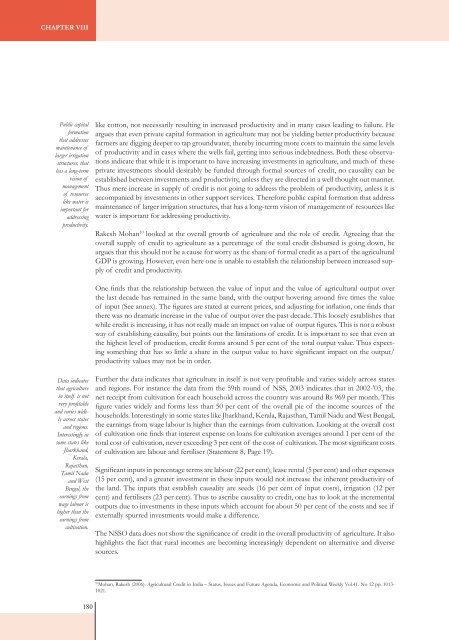SOIL Report 2008 - ACCESS Development Services
SOIL Report 2008 - ACCESS Development Services
SOIL Report 2008 - ACCESS Development Services
You also want an ePaper? Increase the reach of your titles
YUMPU automatically turns print PDFs into web optimized ePapers that Google loves.
Chapter VIIIPublic capitalformationthat addressesmaintenance oflarger irrigationstructures, thathas a long-termvision ofmanagementof resourceslike water isimportant foraddressingproductivity.like cotton, not necessarily resulting in increased productivity and in many cases leading to failure. Heargues that even private capital formation in agriculture may not be yielding better productivity becausefarmers are digging deeper to tap groundwater, thereby incurring more costs to maintain the same levelsof productivity and in cases where the wells fail, getting into serious indebtedness. Both these observationsindicate that while it is important to have increasing investments in agriculture, and much of theseprivate investments should desirably be funded through formal sources of credit, no causality can beestablished between investments and productivity, unless they are directed in a well thought out manner.Thus mere increase in supply of credit is not going to address the problem of productivity, unless it isaccompanied by investments in other support services. Therefore public capital formation that addressmaintenance of larger irrigation structures, that has a long-term vision of management of resources likewater is important for addressing productivity.Rakesh Mohan 10 looked at the overall growth of agriculture and the role of credit. Agreeing that theoverall supply of credit to agriculture as a percentage of the total credit disbursed is going down, heargues that this should not be a cause for worry as the share of formal credit as a part of the agriculturalGDP is growing. However, even here one is unable to establish the relationship between increased supplyof credit and productivity.One finds that the relationship between the value of input and the value of agricultural output overthe last decade has remained in the same band, with the output hovering around five times the valueof input (See annex). The figures are stated at current prices, and adjusting for inflation, one finds thatthere was no dramatic increase in the value of output over the past decade. This loosely establishes thatwhile credit is increasing, it has not really made an impact on value of output figures. This is not a robustway of establishing causality, but points out the limitations of credit. It is important to see that even atthe highest level of production, credit forms around 5 per cent of the total output value. Thus expectingsomething that has so little a share in the output value to have significant impact on the output/productivity values may not be in order.Data indicatesthat agriculturein itself is notvery profitableand varies widelyacross statesand regions.Interestingly insome states likeJharkhand,Kerala,Rajasthan,Tamil Naduand WestBengal, theearnings fromwage labour ishigher than theearnings fromcultivation.Further the data indicates that agriculture in itself is not very profitable and varies widely across statesand regions. For instance the data from the 59th round of NSS, 2003 indicates that in 2002-’03, thenet receipt from cultivation for each household across the country was around Rs 969 per month. Thisfigure varies widely and forms less than 50 per cent of the overall pie of the income sources of thehouseholds. Interestingly in some states like Jharkhand, Kerala, Rajasthan, Tamil Nadu and West Bengal,the earnings from wage labour is higher than the earnings from cultivation. Looking at the overall costof cultivation one finds that interest expense on loans for cultivation averages around 1 per cent of thetotal cost of cultivation, never exceeding 3 per cent of the cost of cultivation. The most significant costsof cultivation are labour and fertiliser (Statement 8, Page 19).Significant inputs in percentage terms are labour (22 per cent), lease rental (5 per cent) and other expenses(15 per cent), and a greater investment in these inputs would not increase the inherent productivity ofthe land. The inputs that establish causality are seeds (16 per cent of input costs), irrigation (12 percent) and fertilisers (23 per cent). Thus to ascribe causality to credit, one has to look at the incrementaloutputs due to investments in these inputs which account for about 50 per cent of the costs and see ifexternally spurred investments would make a difference.The NSSO data does not show the significance of credit in the overall productivity of agriculture. It alsohighlights the fact that rural incomes are becoming increasingly dependent on alternative and diversesources.10Mohan, Rakesh (2006): Agricultural Credit in India – Status, Issues and Future Agenda, Economic and Political Weekly Vol.41. No 12 pp. 1013-1021.180














